- Your Community
-
- Community Development
- Emergency Services
- Public Transport
- Awards and Nominations
- Grants and Event Funding
- Youth
- Visitor Information Centres
- Volunteer Inductions
- Northern Midlands Climate Change Program
- Facilities
- News and Events
-
- Events & Tourism
-
History
- Monuments and Memorials
- Convict Brick Trail
- Media Releases & Publications
- Choose the Scenic Route Photo Competition

History
The Northern Midlands Council supports artistic excellence and promotes a rich creative history.
Council is committed to enabling the introduction of artworks in public places as a means to enhance our towns and community identity; and to promote the Northern Midlands as a municipal area committed to artistic excellence that is compatible with our heritage and landscape.
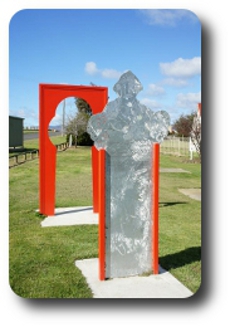 Bush Nurses Commemoration
Bush Nurses Commemoration
Metal Object Maker: Bruno Barcodi.
Description: A tribute to the intrepid Bush Nurses who worked in the Fingal Valley; dealing single-handedly with medical emergencies, sickness and child birth – in often harsh and trying conditions.
Cost: $5 000
Unveiled: International Nurses Day, May 12th 2009 by Tasmania’s Chief Nurse, Ms Fiona Stoker
Location: Boucher Park, Avoca
Inscription:
Information plaque 1: In Recognition of our Bush Nurses
The Bush Nursing Order was established in Launceston, to address the needs of the numerous small and isolated Tasmanian communities that had no means of dealing with medical emergencies and sickness. Thanks to bush nurses, many lives have been saved over the years in the Fingal Valley.
Information plaque 2: A Woman of Substance
Maria Raake, born in 1832, grew up and lived on various properties around here, but not for her the easy life. Maria was a bush midwife and as well as having six children of her own, she delivered approximately 1,000 babies over a 50 year career.
Riding at all hours in all weathers to attend to women in the back country, she experienced many hardships. On one night, up a rocky track towards Ben Lomond, she was thrown from her horse.
She fell on her head and although badly injured and bleeding, she continued on her way on foot. Only once the baby was successfully delivered did she allow someone to take her to a doctor.
Information plaque 3: A Woman of Many Talents
Sister Greta Llewellyn served as a bush nurse at Storys Creek from shortly after the Second World War until 1973 when the mine closed and the town’s population dwindled.
The demands placed upon her over this long period of time were many and varied, including demands which hardly fell within the bounds of her training. As Mrs Johns, wife of the mines underground manager in 1973 described:
“She’s the alma mater of the place. My son would not be alive today if it were not for Sister Llewellyn. He had a heart condition but she sat up with him night after night for five years rather than have him sent to hospital. She later pulled my daughter through rheumatic fever. She has been down the mines and played vetinary (sic) surgeon and dealt with drunks and delivered babies …. Just you name it; Sister Llewellyn has done it.”
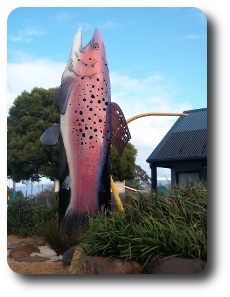 Troutified Toilet Facility
Troutified Toilet Facility
Metal Object Maker: Bruno Barcodi.
Description of the Project: The Troutification of Cressy
Cressy, a small rural Tasmanian town, is known as the ‘Gateway to Trout Fishing Paradise’ - and until 2003 – for very little else. Its streetscape was stark and littered with bleak power poles, vacant shops and rundown features.
Tasmania has a national and international reputation as a superb touring holiday destination, and in late 2003, a group of enthusiastic Cressy residents approached Council for assistance in luring tourists to their town. Council had allocated $60 000 for the redevelopment of the town’s toilet block, and the idea of seeking additional funding to transform the toilet block into a trout themed centrepiece was mooted. An application was made for a Tasmanian Community Fund grant for this troutification exercise and the project hooked in $24 000.
The toilet troutification project captured the imagination of the local school students and businesses, and there was a groundswell of support for the continuation of the troutifying process throughout the town. An application was made for federal government funds to enable the creation of troutified street signage, the troutification of the local swimming pool and cenotaph walls, troutified power pole features, and trout seating. A further $42 000 was received.
The community, supported by a creative artist, commenced the troutification of their town in early 2004. The process proved infectious, with local businesses adopting the theme in their signage and displays, and providing additional funds to enable the troutification of other town features.
The outcome? The Cressy community has been transformed – the town is well and truly troutified in splendid style, it is luring in tourists and the pride of the people of Cressy in their achievements is palpable. And there is no stopping them – they scaled further fishy heights to put their town on the tourist map by holding the inaugural Tasmanian Trout Expo over the weekend of August 27-28 2005.
Over 12 000 people visited Cressy to enjoy the Expo’s fishing competition at the local nationally renowned trout fishing waters – Brumbys Creek – as well as the Expo exhibits, displays, demonstrations, fishy fashion parade, chef’s cooking sessions and interactive bug activities on show at the school.
The troutification venture has not only transformed the visual appearance of the town. It has also given the town’s residents and school students renewed pride in their town – and the opportunity to showcase the town and its people nationally (media coverage of the first Expo was extensive, including a 2-hour live ABC radio broadcast, TV coverage and 60 Minutes coverage). Many school students worked intensively planning and carrying out components of the Expo including the fishy fashion parade, waster recycling, exit interviewing and the fishy art show. They learnt new skills and thoroughly enjoying working the entire weekend to ensure their school and the Expo activities sparkled. The town has also benefited economically from the increased visitor numbers and associated increase dollar spend at local businesses.
The Trout Expo Committee organises the Expo on an annual basis, with the 7th Expo being held in September 2011.
No bones about it, the troutification venture and Trout Expo have positioned Cressy prominently on the tourist map: Cressy has scaled great heights and lured visitors to the town – many of whom are now hooked on trout fishing – that’s it: this synopsis is fin….shed!!
Cost: $10 000
Unveiled: On November 19th 2004, by Mayor Kim Polley
Location: In the park on the corner of Main and Church Streets, Cressy
Inscription:
“Cressy, taking its name from an English syndicate formed to breed horses and other stock on a land grant of 20 000 acres, was established circa 1855. The town is backdropped by the splendid Western Tiers.
The district became famous for its wheat and sheep farming and its large landholders, stud stations and farms. Although no longer known for its wheat industry, the wool growing industry, and its sheep stations have survived and are still a predominant industry for the area. Today trout farming, the Cressy-Longford Irrigation Scheme, and an abattoir contribute to Cressy’s economic well being. Developing industries include trout tour guiding and visitor accommodation.
The Cressy area is renowned for its recreational fishing and is widely recognised as the home of Tasmania’s best all-round river trout fishing at Brumbys Creek, the Weirs, the Macquarie and Liffey rivers. Cressy is also known as the Gateway to Trout Fishing Paradise as it is on the route to the Central Highlands and Great Lake.
The ‘Troutification of Cressy’ initiative, a creation of the Cressy Community, is proudly sponsored by The Department of Transport and Regional Services, the Tasmanian Community Fund and the Northern Midlands Council.”
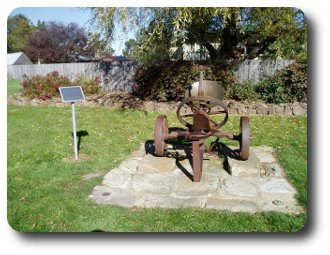 Transit of Venus Sundial
Transit of Venus Sundial
Creator: Dr Tony Sprent, Senior Surveying Lecturer (Retired), University of Tasmania
Description: The sundial was built to commemorate the Transit of Venus observation from Campbell Town on June 8th 2004. The previous Transit of Venus in 1874 was also observed from Campbell Town by the United States Naval Observatory. It was on eo f8 sites worldwide selected by the Naval Observatory for this observation. The scientific data collected was used to improve the calculation of distances between the planets and the sun.
The sundial, ‘accurate to the within a minute’ according to Dr Sprent, is built from bits and pieces of old farm machinery including the wheels from a timber jinker, a seat from a tractor, and gears from a cultivator. A plough disc recast in bronze is the sundial’s face. The sundial rests on a sandstone plinth that was locally quarried.
Cost: $1 000 – Dr Sprent kindly donated his time free of charge.
Unveiled: On the day of the Transit: June 8th 2004 by the Governor, Dr Richard Butler
Location: Valentine’s Park, Campbell Town
Things You Might Not Know About the Transit of Venus:
A transit of Venus occurs when Venus lines up directly between Earth and the Sun. It is like a solar eclipse, but instead of the Moon passing across the Sun, it is the planet Venus. And as Venus is so much further away from Earth than the Moon, it appears to us as a very small black dot when it moves across the face of the Sun.
There have been only eight occasions since 1518 that Venus has passed directly between Earth and the Sun. When the June 2004 occurred, it was the first one since 1882. No-one living on the planet at the time had ever seen one before!
Yet two transits of Venus will occur within the space of eight years at the beginning of the 21st Century – in 2004 and 2012. In fact, the transits currently come in pairs –eight years apart- followed alternately by spans of 121 years and 105 years. So our next date with Venus, after the transit in 2012, will be 2117.
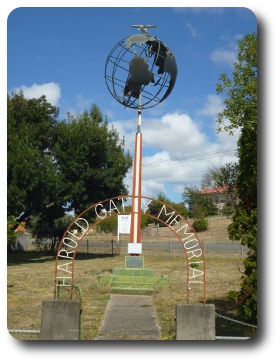 Harold Gatty Memorial
Harold Gatty Memorial
Location: High Street, Campbell Town
Inscription: This monument is to honour the memory of Harold Gatty who is 1931 won world fame as an air navigator after his record breaking flight with Wiley Post in the "Winnie Mae". During the second world war as a Group Captain in the R.A.A.F. he was director of air transport for the allied forces in the Pacific area. Born at Campbell Town 1903. Died at Fiji 1957. This memorial was constructed by the Hobart Technical College. J.C.O'Brien Warden 1960.
Things You Might Not Know About Harold Gatty:
Harold Charles Gatty was an Australian navigator, inventor and aviation pioneer. Charles Lindbergy called Gatty the "Prince of Navigator". In 1931, Gatty served as navigator, along with pilot Wiley Post, on the flight which set the record for aerial circumnavigation of the world, flying a distance of 24 903 kms in a Lockheed Vega named the Winnie Mae, in 8 days, 15 hours and 51 minutes.
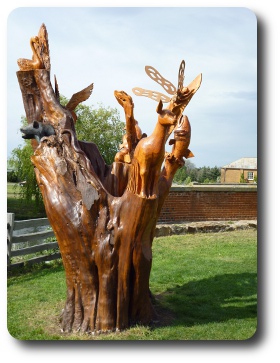 Campbell Town Chainsaw Sculptures
Campbell Town Chainsaw Sculptures
Sculptor: Eddie Freeman
Description: Three macrocarpa trees planted in the 1930s required to be felled due to poor health were turned to beautiful sculptures depicting various features of Campbell Town.
The tree closest to the Red Bridge has a heritage theme with convicts and soldiers.
The second tree features carvings highlighting the area’s natural and agricultural aspects, including platypus, duck, trout, deer, Tasmanian devil and dragonfly.
The last tree pays tribute to some of the prominent people from Campbell Town’s history; these are Dr Valentine, Harold Gatty and Martin Cash.
Cost: $32 000
Date Unveiled: May 2010
Location: Blackburn Park (adjacent Red Bridge), Campbell Town.
Things You Might Like to Know About These Sculptures:
There is a Harold Gatty Memorial located at High Street, Campbell Town.
Dr William Valentine emigrated to Tasmania from England with his wife and family in 1939. Dr Valentine went to Campbell Town on 14 February 1840 as a locum tenens district assistant surgeon. He raised funds to build the Campbell Town Hospital, to which he donated his services for its first two years of operation. He remained the district medical officer to the hospital and town until his death in 1876, aged 68. Dr Valentine built The Grange, probably using convict labour. Dr Valentine was a man of many talents however it was astronomy that made him famous. He organised a scientific expedition of American astronomers to come to Campbell Town in 1874 to observe the Transit of Venus. Valentine Park located in the heart of Campbell Town was named to honour Dr Valentine’s contribution.
Martin Cash (1808-1877), bushranger, was born at Enniscorthy, County Wexford, Ireland. He arrived in Tasmania in 1837 after fleeing New South Wales to avoid arrest for cattle rustling. He worked in Campbell Town in 1838 as a mason’s labourer before being sentenced to seven years for stealing from his employer. He repeatedly escaped and eventually was incarcerated at Port Arthur. On Boxing Day 1842 he escaped from Port Arthur and immediately turned to bushranging, seeking out properties of the rich and unsuspecting travellers and creating fear and consternation across the state. He became the state’s most notorious bushranger. He was recaptured in Hobart in August 1843 and sentenced to death. Cash reportedly had great charm plus a reputation for chivalry, even as a criminal. This is evidenced by the fact that within an hour of being sentenced to death, he was reprieved and sentenced to imprisonment on Norfolk Island. Cash seemed to see the error of his ways and became a model prisoner, working as a domestic servant for a government official. Cash received his “Ticket of Leave” in 1853 and returned to Hobart to work as a gardener at the Government Domain. He received a full pardon in 1863: he was now 55 years of age a free man. After a prosperous four years working in New Zealand, Cash returned to Tasmania and built 60 acres at Glenorchy. He farmed this land until his death in 1877.
The Red Bridge was built by convict labour in 1837-1838. Each convict was paid six pence per day. Some convicts received an additional payment as we learn from reading an extract from a letter written by Forth (Site Supervisor / Police Magistrate) to Cheyne (Inspector of Roads and Bridges) in August 1837.
“Two men of this party employed daily in three and a half feet of water in shifting the shears placed along side the piers for the purposes of putting on the string course of the bridge. They have to enter the water three or four times a day which might prove very injurious to them if they did not receive a glass of rum each time upon coming out of the water… I consider it fair the Government should pay for it.”
At the peak of construction, 220 convicts were working on the project.
To this day, the Red Bridge has needed no major repairs despite being the only north-south artery in the state.
 Harry Murray Memorial
Harry Murray Memorial
Sculptor: Peter Corlett www.petercorlett.com
Description: A bronze statue of Australia's mostly highly decorated soldier of World War 1, Lieutenant Colonel Harry Murray depicting him in war action. Right arm high after having just released a hand grenade and clutching in his left hand his trusty revolver.
Cost: $85 000
Date Unvield: The memorial was unveiled on 24 February, 2006 by his excellency Major General Jeffery AC, CVO, MC Governor - General of the Commonwealth of Australia.
Foundary: Casting by Meridan Sculpture Founders
Location: Main Street, Evandale
Inscription: "Capt Murray rushed to the front and rallied his men by sheer valour, with his revolver in one hand and a bomb in the other, he was ubiquitous, cheering his men, heading bombing parties, leading bayonet charges or carrying wounded from the dangerously shelled areas, with unequalled bravery. His Company would follow him anywhere and die for him to a man" - from the citation for his Victoria Cross.
Things You Might Not Know About Harry Murray:
His real name was Henry William Murray.
On the 30th September, at the age of 35, Harry enlisted for World War 1. He fought in the Gallipoli Campaign, Western Front, Battle of Somme, Battle of Mouquet Farm, Battle of Passchendaele, Battle of Hamel, Battle of Amiens and the Battle of St Quentin Canal.
Harry Murray was also known as "Mad Harry" on the battle fields as he would go to extradordinary lenghts and care to avoid losing any of his men.
Murray was wounded twice while fighting in Gallipoli. In the first incident he recieved a gunshot wound to the knee and was sent to Egypt. Despite being posted to a hospital ship set to return to Australia, Murray was going to have none of that and instead hopped on a transport bound for Gallipoli. Once again he was wounded while manning a machine gun while covering the 4th Brigades withdrawal of Hill 971. The following month he found himself once again evacuated to Egypt, this time for dysentery. Murray returned once again to Gallipoli.
Harry Murray is the most highly decorated infantry soldier of the British Empire during World War 1. He is the receipient of the Victoria Cross, Camanion of the Order of St Michael and St George, DSO & Bar (Distinguished Service Order), Distinguished Conduct Medal and the Croix de Guerre. He was also mentioned four times in despatches.
Murray was re-enlisted during World War 2 and was appointed commanding officer of the 26th (militia) Battalion.
Reference: Public Art Around the World
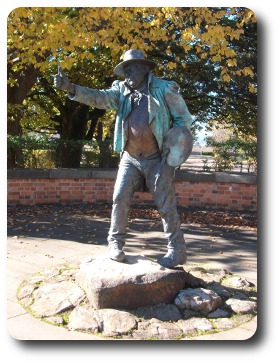 John Glover Statue
John Glover Statue
Sculptor: Peter Corlett www.petercorlett.com
Description: A bronze true life size statue of English / Australian artist John Glover.
Commissioned by: The John Glover Society Inc
Date Unveiled: The statue of John Glover was unveiled on the anniversary of his birthday (and also the date he arrived in Tasmania in 1831), 18 February 2003 by the Governor of Tasmania, the honourable Sir Guy Green AC, KBE, CVO.
Location: Falls Park, Evandale
Inscription: John Glover was born on February 18th, 1767 at Houghton-on-the-Hill, near Leicester, England. He became a landscape artist of high repute and a member of the British Society of Painters in Watercolours, of which he was elected President in 1807.
He first exhibited in oils in 1799 at The Royal Academy, London, and had his first major success as a painter in the medium. Continuing to exhibit at The Royal Academy, he sold his view of Durham Cathedral in 1812 for 500 guineas. He exhibited in Paris in 1814, and was presented with a gold medal by Louis XVIII. In 1820 John Glover opened his own gallery at 16 Bond Street, London and was very successful. Three of Glover's sons left England for Van Diemen's Land (Tasmania), arriving in 1829. Two years later John Glover and his wife Sarah joined them, arriving at the River Tamar near Launceston on the artist's birthday, February 18th, 1831. He was allocated land at Mill's Plains, Ben Lomond (Deddington) where he built his home. The property, which he named "Patterdale", is approximately 20km from Evandale. It is from there he painted wonderful Tasmanian scenes of his newly discovered "Arcadian" landscapes.
In 1835 he sent works to London for an exhibition depicting the scenery and customs of the inhabitants of Van Diemen's Land. In November 2001 one of these paintings, "Mount Wellington and Hobart Town with Natives Dancing and Bathing", sold for more than $1.5 million. His oil paintings are on display at the Queen Victoria Museum in Launceston, Tasmania Museum and Art Gallery in Hobart, major Australian and British art galleries and the Louve in Paris.
John Glover died at "Patterdale on December 9th, 1849 and is interned in a vault at Nile Chapel, Deddington.
Things You Might Not Know About the John Glover:
John Glover is known as the "father of Australian landscape".
He came to live in Australia at the age of 64 years and acquired one of the largest land grants in Van Diemen's Land at the time.
He named his new property Patterdale in honour of Blowick Farm, a property he once owned near Patterdale in the English Lake District.
John Glover had two club feet and weighed over 18 stone.
He started his painting career by copying paintings of the great masters.
His last brush to canvas was completed on his 79th birthday.
He was nicknamed the "English Claude" as he had a similar style to 17th century French painter Claude Lorrain.
Each year Evandale hosts the Glover Prize for landscape painting of Tasmania with the prize money of $35 000 and a minature bronze sculpture of Peter Corlett's John Glover statue.
Reference: Public Art Around the World
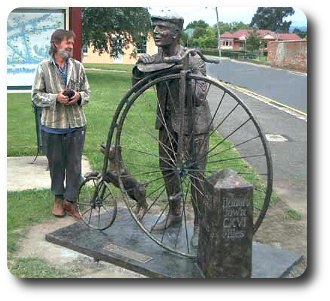 The Time Traveller Sculpture
The Time Traveller Sculpture
Sculptor: Ron Gaston
Description: A bronze sculpture of a man, his dog and a pennyfarthing.
Date Unveiled: 2001
Location: Russell Street, Evandale
Inscription:
The Time Traveller
Celebrating the Centenary of Federation 1901 - 2001
Supported by the Commonwealth Government
Artist - Ron Gasto
Longford Legends
Description: The Longford Legend project recognises people, organisations, and events worthy of the title "Longford Legends". The individuals and organisations recognised are those who have made astrong contribution to the community. It aims to inspire future generations in our region to strive to meet, and where possible, exceed their aspirations.
The Longford Legends Trail will continute to grow over the years. Take a stroll and see the plaques in place along the walk, or view them here.
Date opened: December 2nd, 2020
Location: Abel Tasman Way, Stokes Park, Union Street, Longford
Tom Roberts
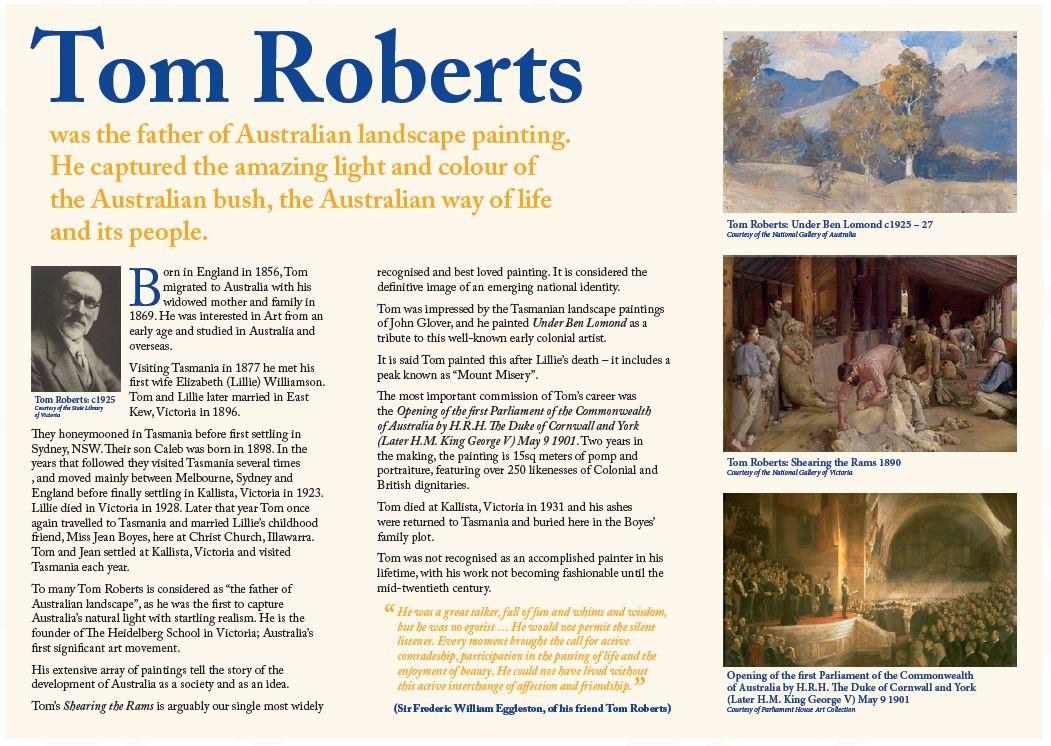
Tom Roberts was the father of Australian landscape painting. He captured the amazing light and colour of the Australian bush, the Australian way of life and its people.
Born in England in 1856, tom migrated to Australia with his widowed mother and family in 1869. He was interested in art from an early age and studied in Australia and overseas. Visiting Tasmania in 1877 he met his first wife Elizabeth (Lillie) Williamson. Tom and Lillie later married in East Kew, Victoria in 1896. They honeymooned in Tasmania before first settling in Sydney, NSW. Their son Caleb was born in 1898. In the years that followed they visited Tasmania several times, and moved mainly between Melbourne, Sydney and England before finally settling in Kallista, Victoria in 1823. Lillie died in Victoria in 1928. Later that year Tom once again travelled to Tasmania and married an old family friend, Miss Jean Boyes at Christ Church, Illawarra. Tom and Jean settled at Kallista, Victoria, and visited Tasmania each year.
To many Tom Roberts is certainly considered to be the first artist to capture Australia’s natural light with startling realism. He is the founder of The Heidelberg School in Victoria; Australia’s first significant art movement.
His extensive array of paintings tell the story of the development of Australia as a society and as an idea. They show us sparkling coast and dusty interior, the sophisticated city and the productive countryside, Aboriginals and immigrants, bright-eyed little girls and crusty old squatters, ladies with parasols and men with guns, politicians and bullockies, people making music and people making roads.
Tom was impressed by the Tasmanian landscape paintings of John Glover, and he painted Under Ben Lomond as a tribute to this well-known early colonial artist.
Tom’s Shearing the Rams is arguably our single most widely recognised and best loved painting. It is considered the definitive image of an emerging national identity.
The most important commission of Tom’s career was the Opening of the First Parliament of the Commonwealth of Australia by H.R.H. The Duke of Cornwall and York (Later H.M. King George V) May 9 1901. Two years in the making, the painting is 15sq meters of pomp and portraiture, featuring over 250 likenesses of Colonial and British dignitaries.
Tom died at Kallista, Victoria in 1931 and his ashes were returned to Tasmania and buried in the Boyes’ family plot.
“He was a great talker, full of fun and whims and wisdom, but he was no egotist … He would not permit the silent listener. Every moment brought the call for active comradeship, participation in the passing of life and the enjoyment of beauty. He could not have lived without this active interchange of affection and friendship”.
(Sir Frederic William Eggleston, of his friend Tom Roberts)
This information is on panels located in the information booth in the Longford Village Green, and Christ Church, Illawarra.
Further reading:
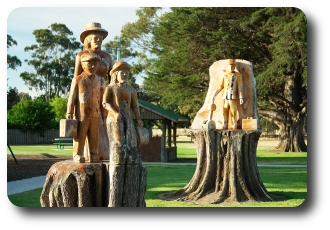 Train Themed Chainsaw Sculptures
Train Themed Chainsaw Sculptures
Sculptor: Eddie Freeman
Description: Quirky chainsaw sculptures that add further emphasis to the ‘train’ theming of Perth Lions Park. The sculptures were created at the same time as the redevelopment of the toilet facility with a train park theme.
Cost: $9 000 (part funded through a Tourism Tasmania Local Tourism Grant)
Unveiled: March 10th 2006
Location: Perth Lions Train Park, Main Road, Perth
 Perth Puntification Project
Perth Puntification Project
Metal Object Maker: Bruno Barcodi.
Description of the Project: Perth Puntification Project
The town of Perth was marked out by Governor Macquarie in 1821, it was originally named “The Punt” as it was here that travellers to/from Launceston and Hobart were ferried across the South Esk river by punt. An inn, quarters for a military garrison, gaol and cottages rapidly developed around the punt crossing site. Stories abound regarding the exploits of the puntsmen who history records
“as being inclined to be careless, or to get drunk. Mr Knowlan’s bullock wagon from Native Point, for instance, tilted off the end of the punt into deep water, causing great loss and a law case at Longford. Drunkenness was proven to be the case.”
(Source: Longford Past and Present. K.R von Stieglitz – undated: p41.)
The ongoing problems with the operation of the punt caused the Government to be petitioned in 1835 to build a bridge over the river. The Government agreed to this and the bridge was finished in 1839, thus ending the punt’s 18 years of service.
Cost: $26 200
Unveiled: 2007
Location: Old Bridge Road, Perth
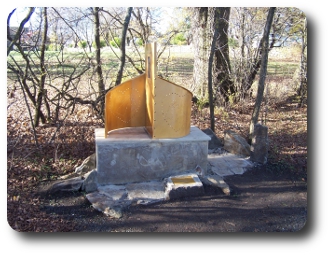 Skulduggery Love Seat
Skulduggery Love Seat
Metal Object Maker: Bruno Barcodi.
Description: A tribute to the mischief, skulduggery and romance surrounding the building of the Ross Bridge. The full story can be read in “Arch Villains”: a nineteenth century detective story for all rambling coves, likely lads and sharp witted misses. The “Arch Villians” enables you to follow in the footsteps of John James, convict constable and master sleuth, as he investigates an authentic case of Van Diemonian skulduggery. Discover how the bridge at Ross took so long to build, grapple with the mysteries of Dr Zweigle’s code breaker, and find the sinister truth behind the 1834 Christmas Day riot. Can you use the clues to solve the mystery?
“Arch Villians” is one of a series of three Skulduggery stories. The books can be ordered online as www.heritagehighway.com.au. The website also holds a list of places where the books can be purchased in the Heritage Highway Region.
Cost: $4 000
Unveiled: Valentine’s Day, February 14th 2006 by Mayor Polley
Location: On the bank of the Macquarie River, adjacent to the Ross Caravan Park
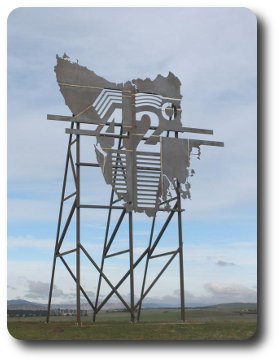 42nd Parallel Project
42nd Parallel Project
Artist: Rebecca Coote
Description: The project celebrates the 42nd parallel in Tasmania’s political and social history with a major cultural installation adjacent to the Midland Highway at the 42nd parallel and an interpretive site in the Ross township.
Few Tasmanians are aware that, between 1804 and 1812, the first political boundary in Van Diemen’s Land divided the island across the 42nd parallel. In 1804 settlements had been made in the south of the island on the Derwent River by Bowen and Collins. An order from the British government required Governor King in NSW to send William Paterson to Port Dalrymple to establish a settlement in the north. Paterson declared he would only proceed with a settlement at Port Dalrymple if he did not have to be under the command of Collins. King solved the matter by declaring the 42nd parallel a boundary between the northern country of Cornwall (under Paterson) and the southern county of Buckinghamshire (under Collins). In a letter to his brother in 1807, Surveyor Harris remarked that he was about to set off on an expedition from south to north of the island and then across its breadth from east to west to survey the boundary at the 42nd parallel. The separation by the 42nd parallel survived in the minds of early settlers in the area, and references to the divide have been found in their descriptions of life at the time. Even in 1820, Evans explained to the Bigge Enquiry that the only division of the island was that made by the 42nd parallel. A century after the cessation of the 42nd parallel as a boundary, Emmett writes an account of his rambles about the island: “The political division was thus removed, but it will take more than an Act of Parliament to sponge away the imaginary line that constitutes in the minds of the people of Tasmania the division of the island into North and South.”
Cost: $90 000
Launched: 16 October 2012 (silhouette complete – the rest of the project is currently under construction)
Location: Silhouette beside the highway north of Ross. Interpretation panels beside the Ross Town Hall.
